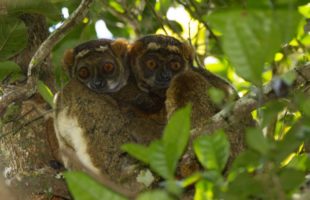#1 Lemurs are only found wild in Madagascar The island of Madagascar is the only country in the entire world where lemurs occur naturally. Only two species of lemurs, the brown lemur, and the Mongoz lemur, were trafficked to the Comoros by humans and have successfully settled there. Many species of lemurs are not even found in zoos today, but …
LesenSchlagwort-Archiv: lemur
Wooly lemurs: everything for the family
Lemurs are generally considered social, peaceful animals. But one lemur, in particular, stands out in terms of its family ties: the eastern woolly lemur (Avahi laniger). The name comes from its slightly curly fur, which no other lemur in Madagascar has. Eastern woolly lemurs live only on Madagascar, they are endemic to the island. Their habitat is on the east coast …
LesenEquality in the rainforest: White-fronted lemurs
White-fronted lemurs (Eulemur albifrons) carry their name thanks to the appearance of the males: They have white fur around their face, which makes them look a bit old and wise. The corresponding females are rather unobtrusively colored and have completely brown fur. With two to two and a half kilos the lemurs are not very large, the weight is more …
LesenThe Ankarana Sportive Lemur
Sportive Lemurs are everywhere in Madagascar. But every place has its own species. In the far north of Madagascar, in the dry forests of Ankarana, lives the eponymous Ankarana Sportive Lemur (Lepilemur ankaranensis). It is widespread as far as the nearby rainforests and dry forests of the Amber Mountain as well as Analamerana and Manongarivo and is only about 25 …
LesenAmber mountain national park
Amber Mountain: The name comes from the flowers of certain trees that cover the mountain and shine amber from afar. Location: The Amber Mountain National Park is located in northwestern Madagascar in the Diana region. The nearest major city is Antsiranana (Diego Suarez) on the coast, about 30 km away. From the capital Antananarivo, the park is located about 1000 …
LesenThe gardeners of the forest: Red-bellied lemurs
One does not often meet red-bellied lemurs (Eulemur rubriventer) in Madagascar, but they play an important role in the rainforest’s fragile ecosystem. Only male wear the eponymic red belly, females are white or cream colored on chest and belly. Males also have white fur below their eyes which lacks in females. At average, red-bellied lemurs weigh one and a half …
LesenAn east-west-conflict: Red-fronted lemurs
In red-fronted lemurs, colour has been distributed inequally: Only males bear the eponymic red forehead. In females, this area is grey coloured. Both genders weigh between two and three kilograms and become only half a meter in size, measured without tail. Until 2008, scientists thought the red-fronted lemur to be a subspecies of the similar looking rufous brown lemur or …
LesenMadagascar’s famous ring-tailed lemurs
They are the unofficial mascots of Madagascar and probably the most famous Malagasy lemurs: The ring-tailed lemurs (Lemur catta). Their portraits grace the logo of Madagascar National Parks (MNP), countless t-shirts, and company emblems. A full-grown ring-tailed lemur weighs maximally 3.5 kg. The ringed tail is 60 cm longer than the whole body which is only 40-45 cm. In contrast …
LesenThe fruit gourmets: Black-and-white Ruffed Lemurs
Many people know them from zoos and animal parks: Black-and-white ruffed lemurs (Varecia variegata). Besides Red Ruffed Lemurs and the Indri, they belong to the largest lemurs with a head-torso length of 40 to 60 cm, an additional 60 cm added for the tail. Weights of 3 to 4 kg are the average. Black-and-white ruffed lemurs exclusively live in the …
LesenDie singenden Lemuren: Indris
Ihre Gesänge gehören zu den eindruckvollsten, die die Tierwelt zu bieten hat: Man kann die Stimmen der Indris (Indri indri) kilometerweit durch den Wald schallen hören, und sie tragen eine eigentümliche Traurigkeit mit sich. Angeführt und begonnen wird der Gesang stets vom Elternpaar einer Familie, das damit sein Revier absteckt, aber auch mit anderen Familien kommuniziert und vor Bedrohungen wie …
Lesen MADAMAGAZINE Your Magazine about Madagascar
MADAMAGAZINE Your Magazine about Madagascar










